|
BOTTICELLI - PRIMAVERA
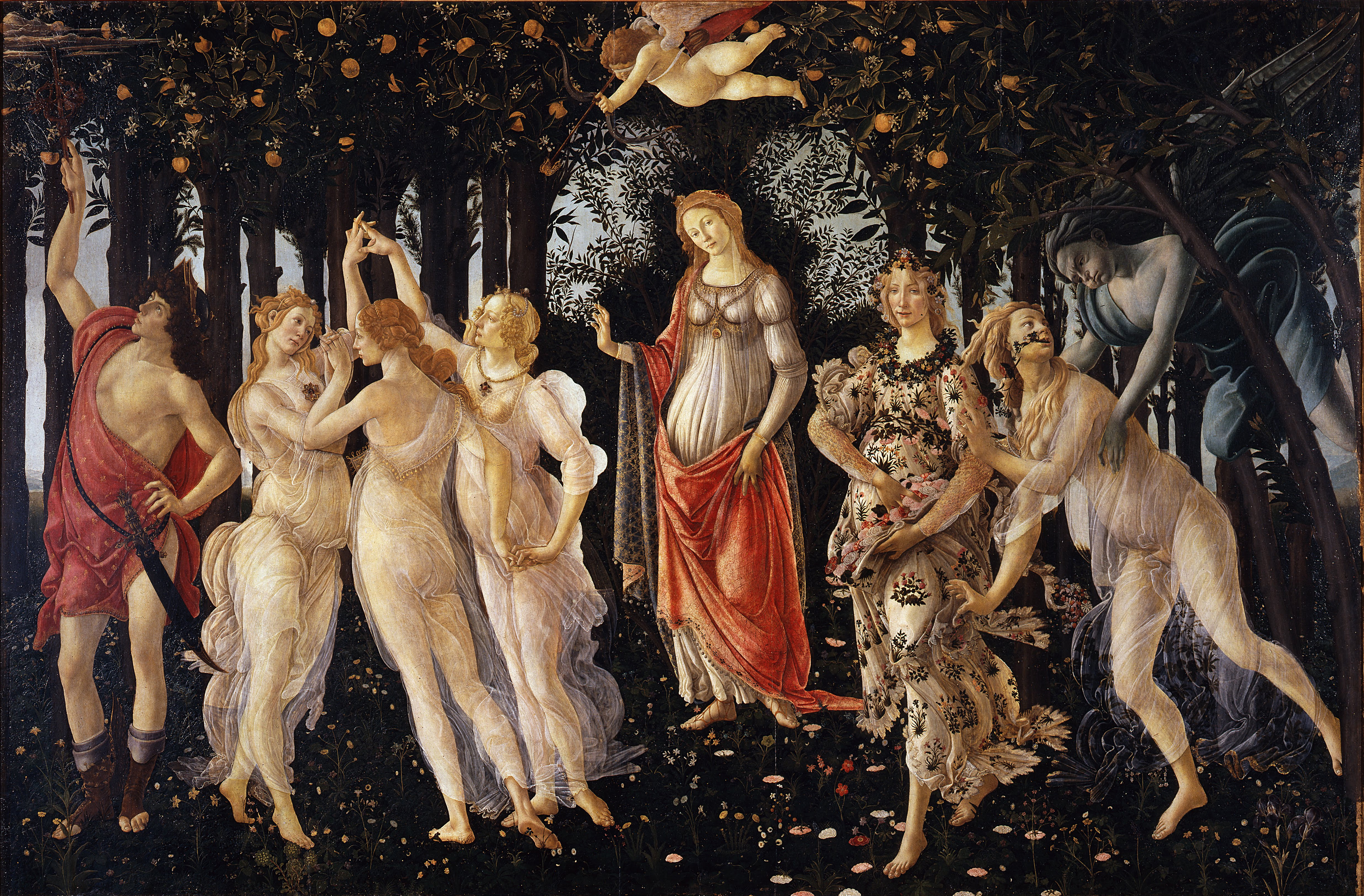
Sandro Botticelli, Public domain, via Wikimedia Commons
c.
1482
|
- Sandro Botticelli, born as Alessandro di Mariano di Vanni Filipepi (1445-1510), was an Italian painter of the Early Renaissance.
- Primavera,
which means spring, is a large painting on wood panel in
tempera created in the late 1470s or early 1480s.
- Venus
in Roman and Aprhodite in Greek is the central theme.
|
Botticelli's intricate composition is a treasure trove of allegory, and "Primavera" is often interpreted as a celebration of the spring season and the rejuvenation of nature. The flowers and foliage, meticulously rendered with a botanist's eye, mirror the theme of renewal and fertility. Yet, beneath this surface lies a deeper layer of symbolism that transcends the seasonal cycle.
(Isabella Martinez)
|

Hidden flower garden |
- The painting depicts a scene from classical mythology that
takes place in a garden and some scholars claim that no one story has been found that links the
figures in this group together, other than they are Greek and Roman
mythology.
- But that is not true, we've discovered the
story of Chloris, goddess of Spring, who with the help of many
gods and goddesses created flowers for us on earth.
-
These are figures who are both human and divine, gathered
together in a verdant landscape all working for nymph Chloris
who turns into goddess Flora.
|
The painting weaves together multiple symbolic threads, astrological, botanical, literary, to create a visual poem of rebirth and harmony.
(understandingitaly.com)
|
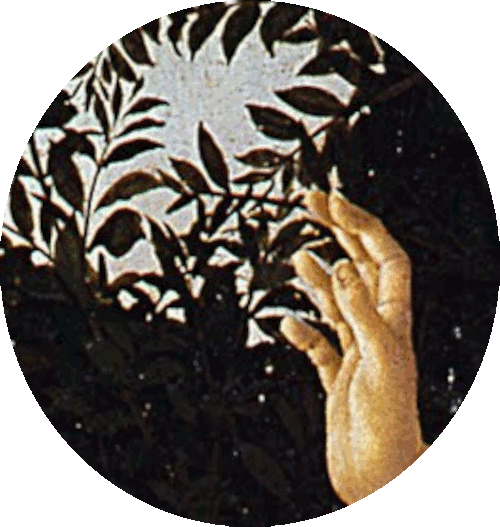
Mirror held up to the universe |
- Botticelli's family was deeply involved in esoteric circles.
- During the Renaissance, there was a deep interest in the intellectual achievements of the ancient world.
- The study of classical texts, including myths and philosophies, ignited a fascination with the wisdom of antiquity.
- Artists like Botticelli embraced these narratives as
vehicles for exploring complex themes and conveying moral
lessons.
- Primavera was never meant to
be just a pretty picture, it was a puzzle, a mirror held up to
the universe's secrets, one that still whispers to those
willing to listen.
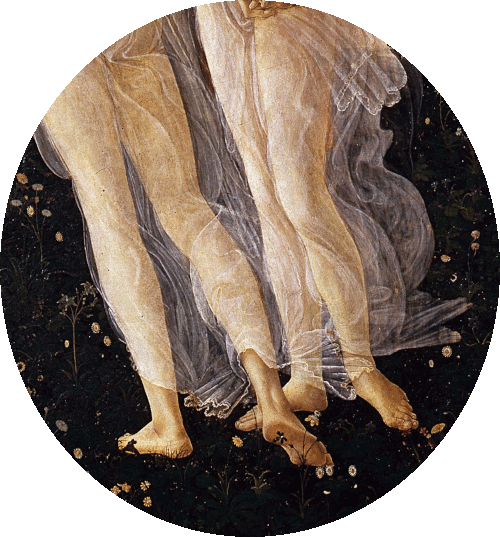
Style of the day |
- Notice the figures have limbs which are long and slender and appear
very elegant.
- Botticelli produced art at a time when there was a demand in the court of Florence for this
romantic stylized look.
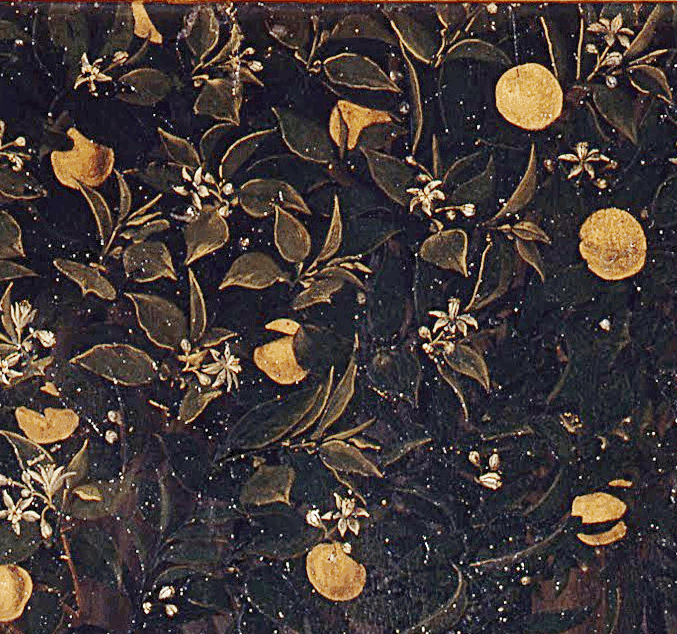
Orange tree |
-
Botticelli was one of the most well-known of the Medici employees.
- He studied under Fra Filippo Lippi and had a technique which focused on line, and his forms were lightly shaded.
- While art historians consider Botticelli to have been an expert at using line, he was also adept at using color.
|
It has been described as "one of the most written
about, and most controversial paintings in the world", and also "one of the most popular paintings in Western art. (Wikipedia)
|

Medici symbol |
- Set in an orange
grove is noteworthy, since the Medici had adopted the bitter orange
tree as its family symbol.
- Botticelli painted the both
Birth of Venus and Primavera for the Medici Villa di Castello, near the hills bordering Florence, Tuscany, central Italy.
- This was the country residence of Cosimo I de' Medici, Grand Duke of Tuscany (1519-1574).
- The gardens, filled with fountains, statuary, and a grotto, became famous throughout Europe.
-
Both paintings now resides in the Uffizi Museum in Florence.
|
Lorenzo il Magnifico may have commissioned Sandro Botticelli's Pallas Athene Taming a Centaur as a wedding gift to the new couple, presumably suggesting that Semiramide (represented by Pallas) should endeavour to "tame" young Lorenzo di Pierfrancesco (represented by centaur) (or more metaphorically, the surrender of brute instincts to the goddess of reason, a reference to Lorenzo di Pierfrancesco's entrance to manhood). (Wikipedia)
|
|
Neoplatonism |
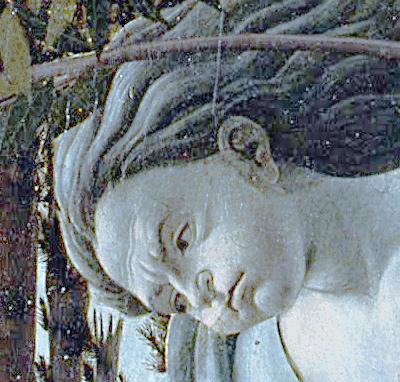
Quiet revolution |
- The church may have ruled the surface, but beneath the
brushstrokes, Renassance artists like Botticelli and DaVinci were part of a quiet revolution.
- A revolution
that blended faith with philosophy combined with hidden
knowledge into timeless masterpieces.
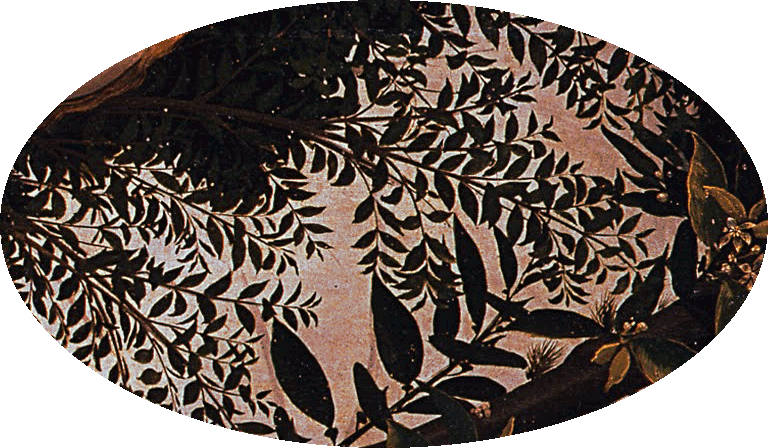
Sunrise |
- The influence of Neoplatonism, a philosophical movement that synthesized elements of Platonism with Christian and mystical thought, is also evident in the painting's composition.
- The movement was begun by
Marsilio Ficino (1433 -1499), who was an Italian scholar and Catholic priest
and one of the most influential humanist philosophers of the early Italian Renaissance.
|
The Neoplatonic Academy of Ficino met in 1475 CE at the Villa Medicea di Careggi in the Florentine hills. The participants imitated the original structure of Plato’s Symposium in which a group of nine notable Athenian men gathered at Agathon’s house to discuss the subject of ‘eros’.
(Achilleas A. Stamatiadis)
|
|
|
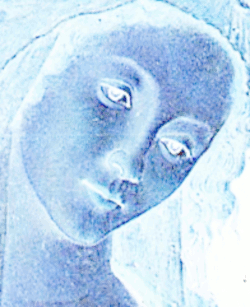
Celestial |
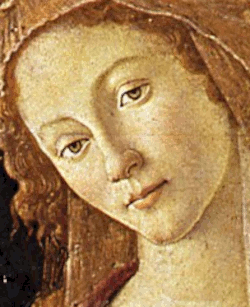
Terrestial |
- Plato’s concept of the Twin Venuses was adopted by Ficino, a distinguished Renaissance humanist.
- Ficino
and other Platonists believed there was a celestial Venus and an earthly
Venus two different aspects: Venus Urania and Venus
Pandemos.
- Along with the Victorian-era poet Alfred Lord Tennyson, both utilized and developed the Platonic model.
- He was a strong supporter of philosopher Plotinus
and the belief in
Plotinian ideas by Ficino and his circle has been attested by several scholars..
|
Antonio Agli, the Bishop of Fiesole, associates Aphrodite Urania with the second highest level of Plotinus, the Angelic Mind. Conversely, he associates Aphrodite Pandemos with the Plotinian realm of the ‘Soul’ or ‘World Soul’ which is only one level higher than ‘Evil’ and ‘Formless Matter’, the lowest level in the Plotinian hierarchy. (Achilleas A. Stamatiadis)
|
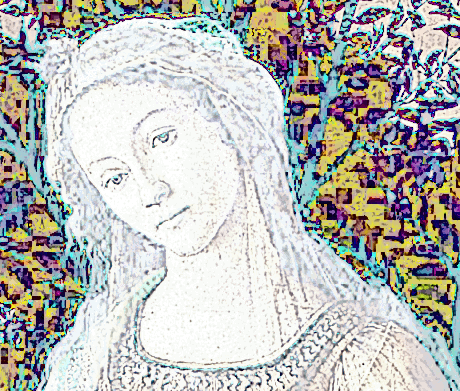
Material girl |
- This was the concept of both Heavenly and Terrestial love.
- Earthly Venus is older and she has no mother since she is
the daughter of heaven and the one we call Aphrodite
celestial.
- The other one is more recent and is the
daughter of Greek god Zeus and goddess Dione and she is the
one we call 'Pandemic' or popular.
- The Latin version
comes from the more ancient Aphrodite who's name means sea
froth.
- Her father was Uranus and she was the fruit of
his seed mixed with sea water, but he was emasculated by his
son Cronus (Saturn).
|
Diotima of Mantinea, a character in Plato's
Symposium, is a priestess and philosopher who
introduces the concept of Platonic love, emphasizing
love's role in the pursuit of wisdom and immortality.
She explains that love is not a god, but a spirit that
bridges the gap between humans and the divine. Through
her teachings, Diotima guides Socrates (and by
extension, Plato's audience) to understand that love's
ultimate aim is immortality, achievable through
procreation or the creation of beautiful and
meaningful things.
(Assistant)
|

Lower ego material world |
- Aphrodite Pandemos and Aphrodite Urania are introduced at the beginning of the Symposium
where Pausanias gave a speech associating them with two discrete types of love.
- The first type, associated with Pandemos, is base love, a profane type under the influence of which the lover seeks only sexual gratification.
|
Once we appreciate that Heavenly love is a non-bodily
love while Terrestrial love is related to body, form
and matter, we can better understand Ficino’s
fascination with Heavenly love as described by Diotima
in Plato’s Symposium.
(Achilleas A. Stamatiadis)
|
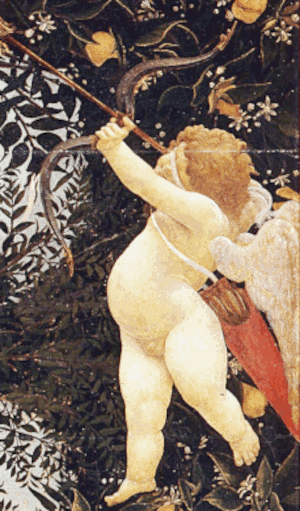
Aim higher |
- The second type of love, related to heavenly Aphrodite Urania, encourages us to love honorably.
- Moreover, love under the influence of Urania concerns honoring both a partner’s soul and wisdom.
- As Socrates noted, philosophers ought to pursue the second type of love.
-
After contemplating the idea of beauty itself, Ficino came
to the belief that beautiful actions in the realm of politics, lawmaking and philosophy, similar to those described by Diotima in
Plato’s Symposium, will ensue.
|
You can see this fire in his famous Primavera (ca. 1480), where Cupid, at the top center, aims a fiery arrow at one of the three Graces, who is on the verge of falling for the young man on the far left. The man is clad in a red mantle showered with inverted flames — an ingenious stroke by Botticelli to convey that, in the eyes of the woman (and ours as well), he has ignited the flames of her passionate desire.
(famsf.org)
|
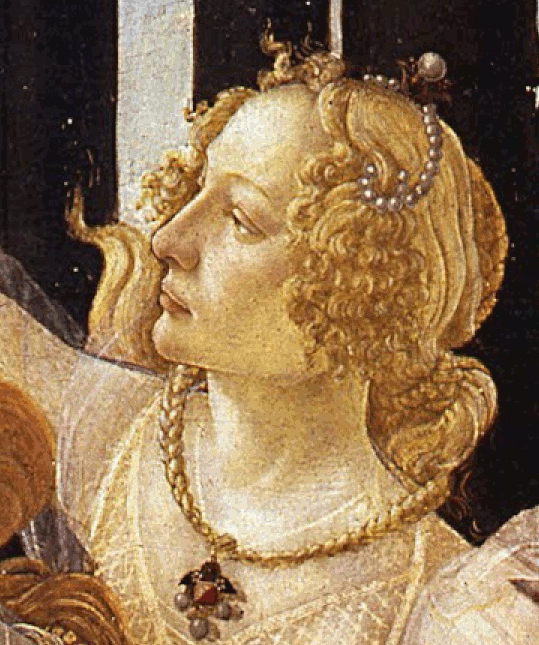
Grace |
- Authors like Ficino and Tennyson tailored the use of Plato’s
Twin Venuses to conform to their own personal aims and agendas
where Ficino was positive and Tennyson was negative.
- Like Ficino in Florence, Tennyson was preoccupied by what he saw as the appalling state of morals in London around the time he wrote
Lucretius.
|
With that he drove the knife into his side.
She heard him raging, heard him fall, ran in,
Beat breast, tore hair, cried out upon herself
As having fail'd in duty to him, shriek'd
That she but meant to win him back, fell on him
Clasp'd, kiss'd him, wail'd.
He answer'd, "Care not thou!
Thy duty?
What is duty? Fare thee well!"
(Alfred Lord Tennyson, Lucretius)
|

Grasping |
- Neoplatonists believed in the interconnectedness of all things and sought to understand the divine through contemplation of the material world.
- The emphasis of the painting on beauty and spirituality, reflects the Neoplatonic philosophy that sought to transcend the material realm and seek higher truths through the study of nature and art.
|
"Primavera" is not only a celebration of myth and
allegory but also a visual manifestation of the
Renaissance spirit. The painting encapsulates the
era's intellectual curiosity, humanistic ideals, and
engagement with ancient wisdom. Botticelli's skillful
fusion of classical mythology, humanist philosophy,
and innovative artistic techniques culminates in a
work that stands as a testament to the Renaissance's
profound impact on art and culture.
(1st-art-gallery.com)
|
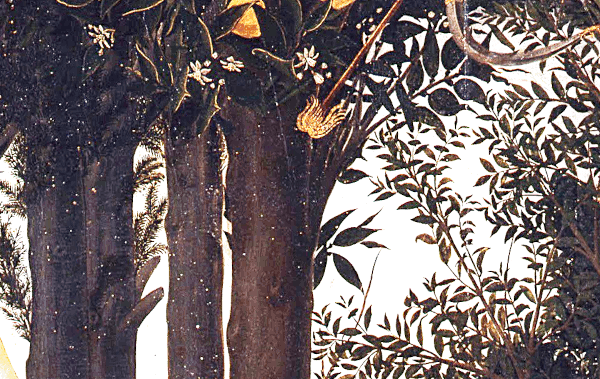
Thinly forested |
- This painting does not use much of the one-point linear
perspective which was popular with early Renaissance masters
who used the method so effectively in the 15th-century.
-
While some atmospheric perspective is visible through the
trees to the right and to the left, we do not see much
depth.
- The effect is a lace covered thinly veiled
forest.
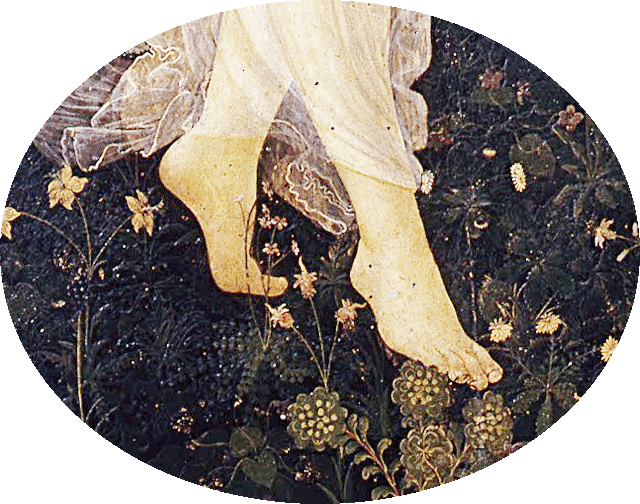
Lush garden |
- Botticelli's Primavera appears as a lush garden
with elegant figures draped in flowing robes, but look
closer and you'll notice something unusual.
- Every
element, from the positioning of the figures to the flowers
under their feet has a deeper meaning.
- It's not just a scene about seasonal
beauty, it carries an allegory, it's a carefully constructed
allegory, steeped in the esoteric philosophies that interested
Botticelli and his patrons.
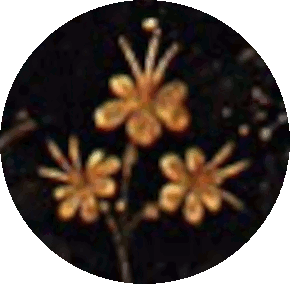
Union between nature and culture |
-
That the scene takes place in a beautiful garden, is an allegory in itself, representing the harmonious union between nature and culture.
- This is an encounter between gods and mortals, and allegories and human figures.
- This fusion of divine and earthly realms echoes Renaissance fascination with the classical past and the revival of mythological narratives.
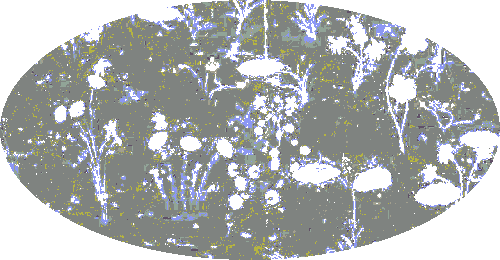
Hidden for the day |
- Even the flowers aren't mere decoration and each bloom
corresponds to specific astrological alignments.
- They
were alignments meticuously chosen to mirror celestial
patterns that Renaissance astrologers believed influenced
human destiny.
- This was more than artistry, it was visual
instruction for those initiated into the hidden philosophies
of the age.
|
Venus |
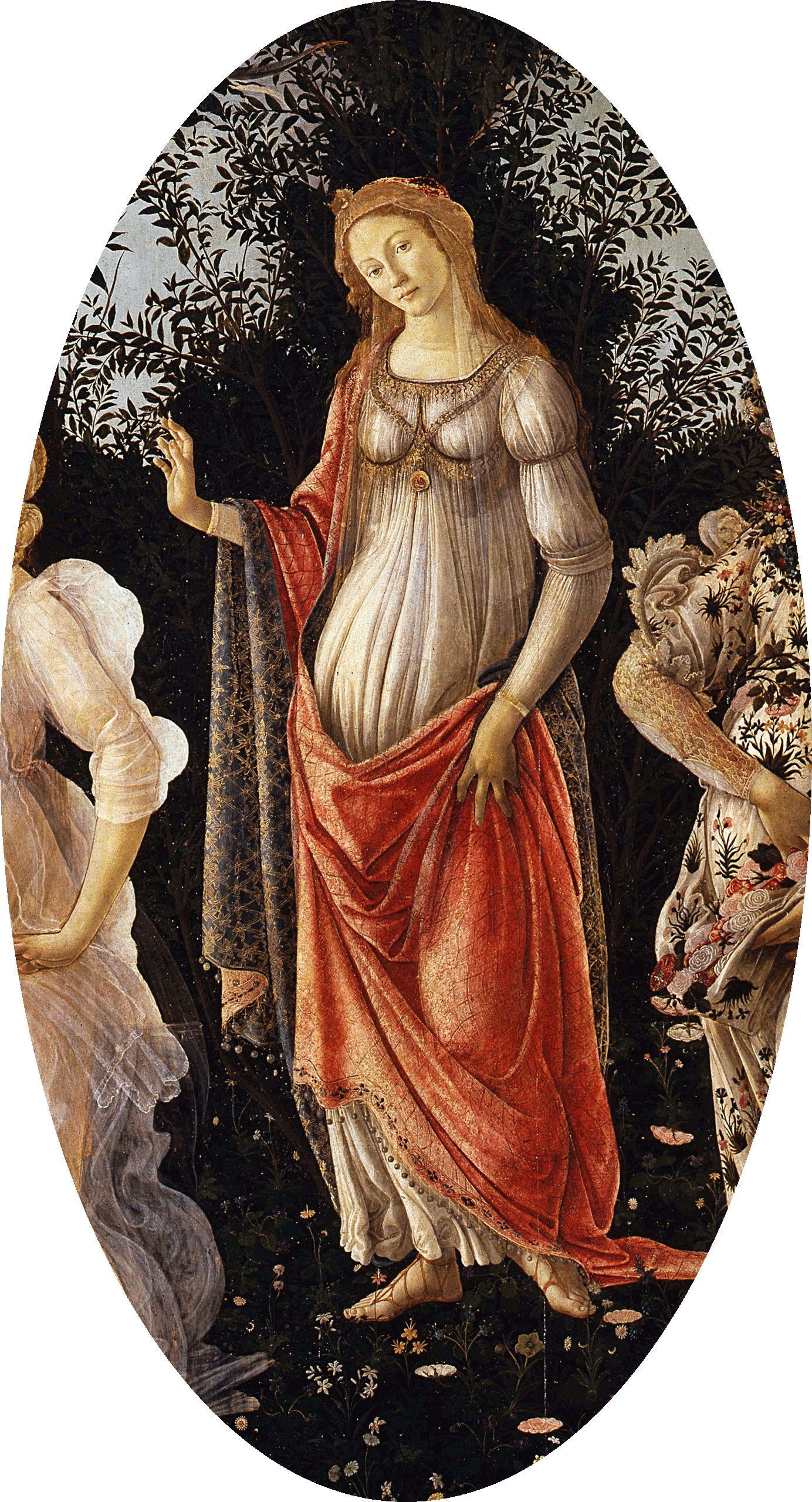
Beneath archway |
- In the center is the Roman goddess, Venus, who appears
pregnant, stands serenely as the main focal point.
- Venus exudes an air of grace and serenity.
- Around her, a dance of allegorical figures takes place, each with its own symbolic significance.
- She's framed by an arch of branches almost like a sacred
gateway or portal.
|
Call if not love, for Love to heaven is fled
Since sweating Lust on earth usurped his name.
(Shakespeare, Venus and Adonis)
|
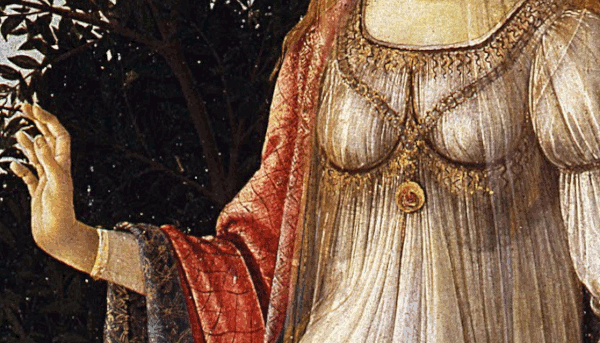
Virginal |
- Here, Botticelli mixes pagan with Christian symbolism.
- He shows us Venus as both goddess, and as a stand in for the
Virgin Mary, embodying the Neoplatonic idea of love as a
cosmic force and much more than mere mortal.
- She holds her right hand up in greeting or blessing.
- In Botticelli's Birth of Venus we see another side
of Venus, as chaste and virginal and newly born..
|
In the stormy Aegean, the genital member is
seen to be received in the lap of Tethys, to drift
across the waves, wrapped in white foam, be-
neath the various turnings of the planets; and
within, both with lovely and happy gestures, a
young woman with nonhuman countenance, is
carried on a conch shell, wafted to shore by
playful zephyrs; and it seems that heaven re-
joices in her birth. (Poliziano's la Giostra, Stanza 99)
|
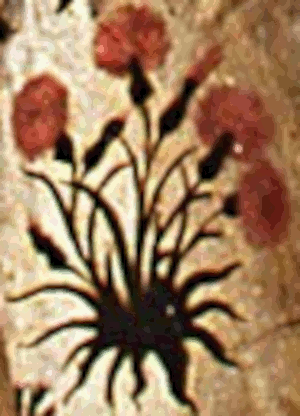
Mari-gold |
- The precise purpose of the painting is unknown, but it was
more than likely created for the marriage of Lorenzo di Pierfrancesco,
age 19, in May
1482.
- He was a cousin of the powerful Lorenzo the Magnificent Medici
who was one of Botticelli's greatest patrons.
- The groom
had been orphaned in 1476 when he was only 13 and he and his
brother Guiliano were placed under the tutelege of their
cousin, Lorenzo the Magnificant.
- His bride was Semiramide d'Appiani, 18, daughter of the Appiani lord Jacopo III of Piombino, who brought not only lucrative commercial ties but also political connections.
- She was originally planning on marrying Guiliano Medici but
he was assassinated.
|
It is believed that also on this occasion, either Lorenzo il Magnifico or Lorenzo di Pierfrancesco himself, commissioned Botticelli's Allegory of Spring to celebrate the wedding - with Mercury representing Lorenzo di Pierfrancesco and Semiramide represented by the central Grace (or possibly Flora). (Wikipedia)
|
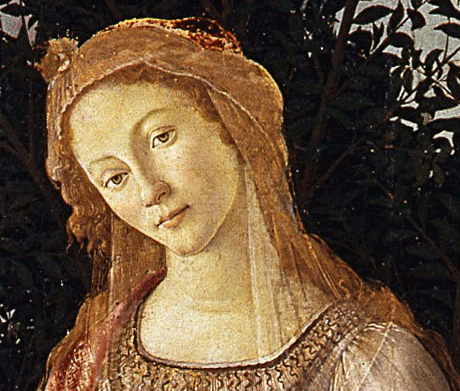
Venus head tilt |
- Venus' presence is a reflection of the humanist interest in the classical world, which was popular in Florence at this time.
- She is depicted as an idealized woman, slightly off-center, with her head tilted and gesturing to her right.
|
The painting would have been placed in Lorenzo di Pierfrancesco’s bedroom and his wife would have seen it for the first time after their wedding, so the idea of Cupid targeting the pure Three Graces with his arrow takes on a particular meaning in light of conjugal
love.
(italianrenaissance.org)
|
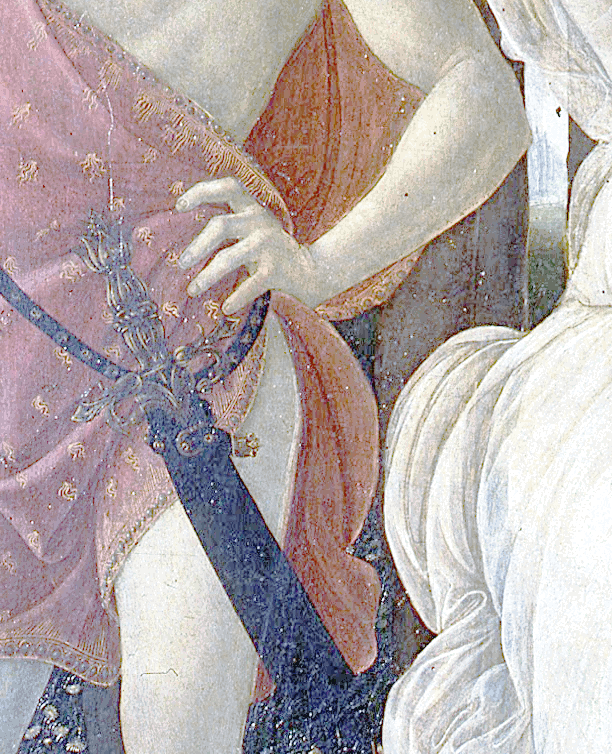
Adonis the boar hunter |
- A rose-scented tale of Aphrodite involves her lover, Adonis, and the myth of how the rose turned red.
- One day, Adonis was out hunting boar. Ares (Mars), god
of war, jealous of Adonis, had secretly sent the wild boar to harm him.
- Aprhodite found out and rushed to warn Adonis but scratched
herself on a rose bush causing a white rose to turn red from
the specks of her blood.
- Unfortunately, she is too late to the scene, and Adonis perishes from a fatal wound to his thigh
but out of her tears mixed with blood, the anemone flower is
born.
|
Rose-cheek'd Adonis tried him to the chase; Hunting he lov'd, but love he laugh'd to scorn; Sick-thoughted Venus makes amain unto him, And like a bold-fac'd suitor 'gins to woo him.
(Shakespeare, Venus and Adonis)
|
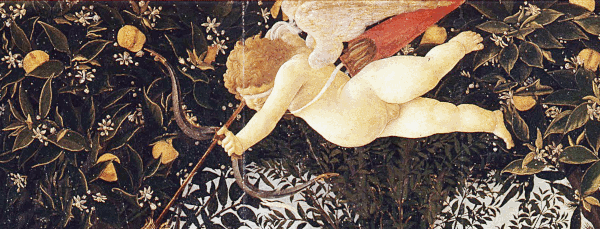
Cupid
|
- Cupid, who is borne on wings, Venus's mischievous son, hovers above her, ready to launch his
flaming arrows of desire.
- His inclusion reinforces the theme of love's transformative power, which extends beyond the realm of the gods and influences mortal hearts.
- Behind him the tree limbs form an arch which conveniently frame Venus and provide her with a privileged position in the painting.
|
His playful presence serves as a reminder that love can be both enchanting and unpredictable a sentiment that resonates with human experiences across cultures and eras.
(Isabella Martinez)
|
|
Mercury is Hermes |

Reaching up with caduceus staff |
- Then there's Mercury, who is the god of the month of
May, poised on the far left,
reaching up with his caduceus, which has also been called
Hermes staff.
- The caduceus was the symbol of
medicine, but in Botticelli's time it held a more mystical
significance.
- Entwined serpents mirrored the union of
opposites which is a key Hermetic concept representing balance
between heaven and earth, spirit and matter.
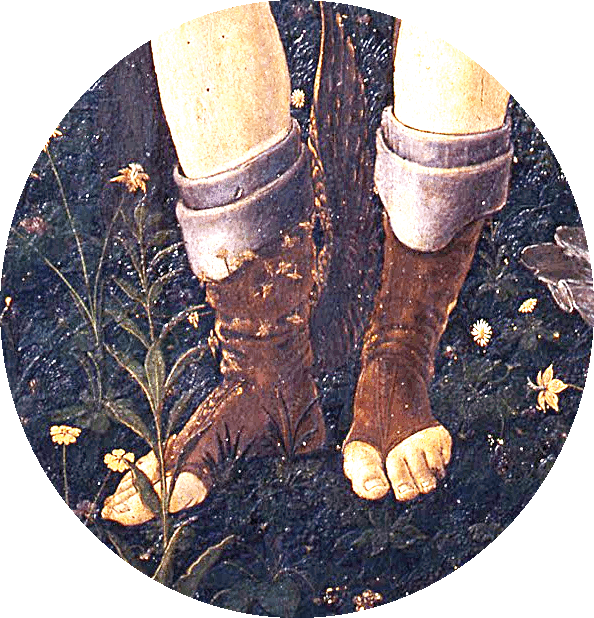
Mercury with winged feet |
- His gesture
toward the sky wasn't random, it hinted at the souls ascent
toward divine knowledge.
- He is readily identifiable by his prominent winged sandals.
|
Angels and ministers of grace defend us.
(Shakespeare)
|
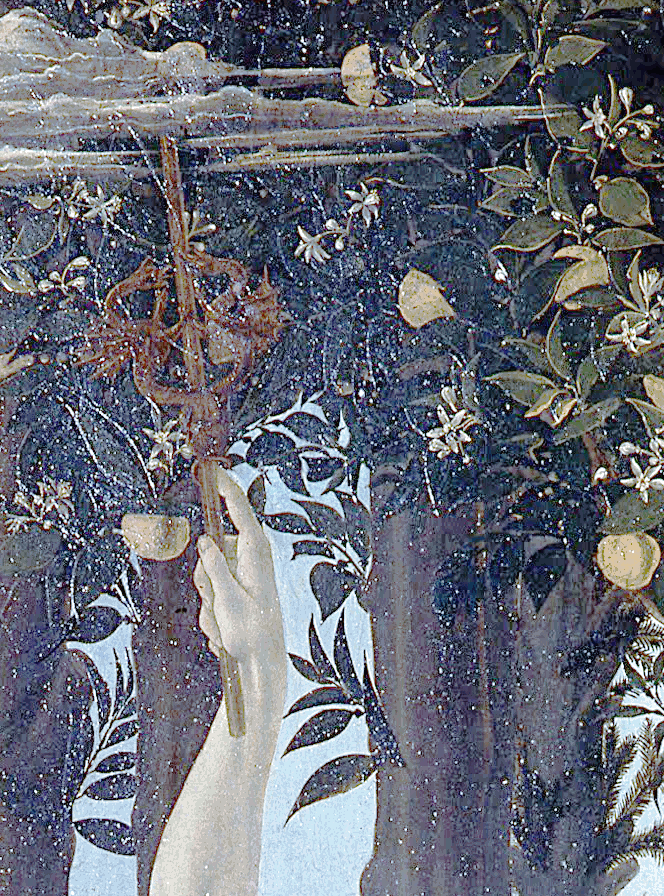
Staff of Hermes connected to the cloud |
- Mercury is also the god of communication and commerce.
- He soars through the sky, carrying the staff of Hermes and his presence introduces an element of movement and transition, suggesting the passage of time and
hope for prosperity.
- Mercury's role as a messenger emphasizes the idea of interconnectedness between the divine and human realms.
|
Speak, fair, but speak fair words, or else be mute.
(Shakespeare, Venus and Adonis)
|
|
Three Graces |
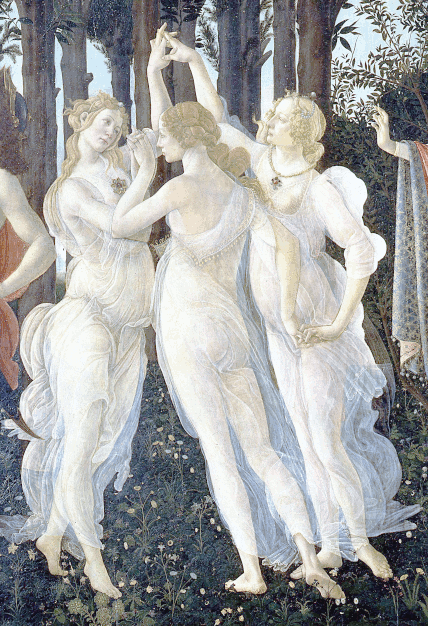
Dancing in a circle |
- The allegorical figures that surround Venus contribute to the painting's intricate narrative.
- They stand in harmony as they intertwine hands in a graceful dance.
- The
Three Graces, dancing in their delicate circle
represent charm, beauty, creativity and joy, yet to Neoplatonic thinkers,
they symbolized something far deeper.
- Also called the Charites known as Thalia, Euphrosyne, and Aglaea,
who gave blessings of charm, joy, and brilliance or splendor.
|
Time be thine,
And thy best graces spend it at thy will.
(Shakespeare)
|
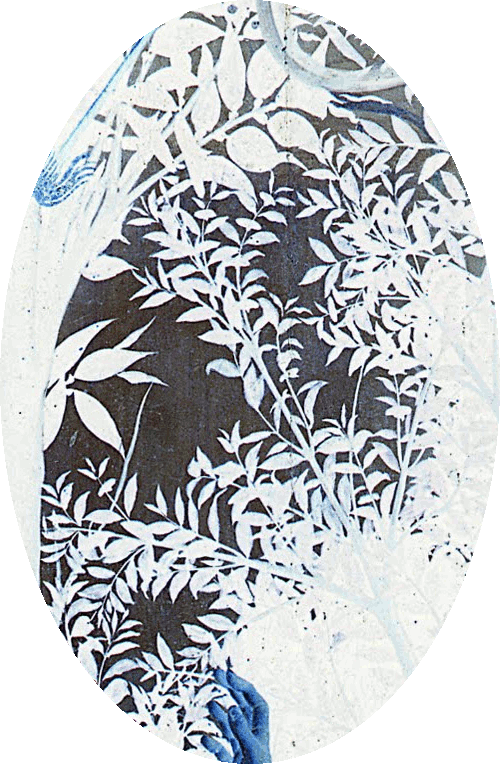
Feminine virtues |
- These figures are important because they represent the feminine virtues of
chastity, beauty, love, all of which point to romance and show what is going on in the painting,
- They are being targeted by Cupid’s arrow, which reinforces
the idea of marriage.
- As they twirl and spin, they symbolize different aspects of human experience.
|
If I could write the beauty of your eyes And in fresh numbers number all your graces, The age to come would say, 'This poet lies; Such heavenly touches ne'er touch'd earthly faces.
(Shakespeare)
|
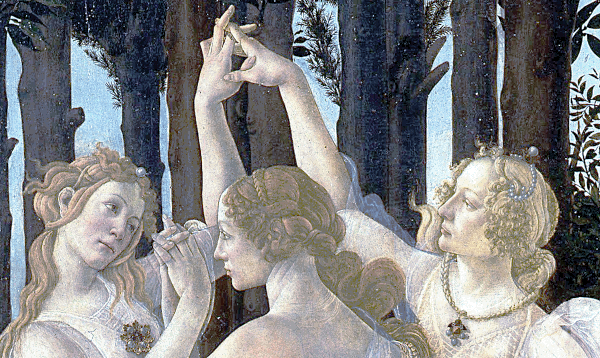
Divine harmony |
- This was the divine
harmony, love, wisdom and truth reflecting the celestial order
of the comets.
- The pearls on their heads symbolize purity.
- Their presence embodies the Renaissance ideal of balanced human virtues and the concept of unity in diversity.
- Even their intertwined hands mimic the
interconnectedness of all things, a core belief in Hermetic
thought.
|
Pure and undefiled and holy in the eyes of all.
(Seneca)
|
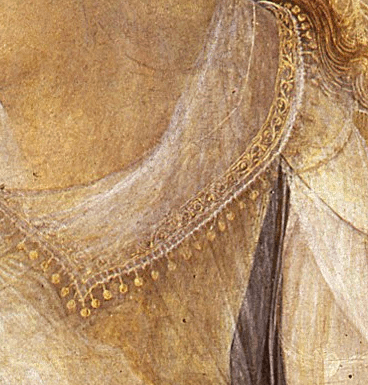
Lacelike |
- Their clothing is like lace, very light, and see-through, which demonstrates Botticelli’s
talent in depicting delicate subjects.
- He is
showing the luxurious Italian silks and gold threaded
fabrics which have a heavenly appearance.
- As early as 1300, Florence was an important center of wool production and during the
14th-century the local industry invested in the development of silk manufacture, which soon became a crucial part of the Florentine economy.
|
O momentary grace of mortal men,
Which we more hunt for than the grace of God!
(Shakespeare)
|
|
The Woodland Rose |
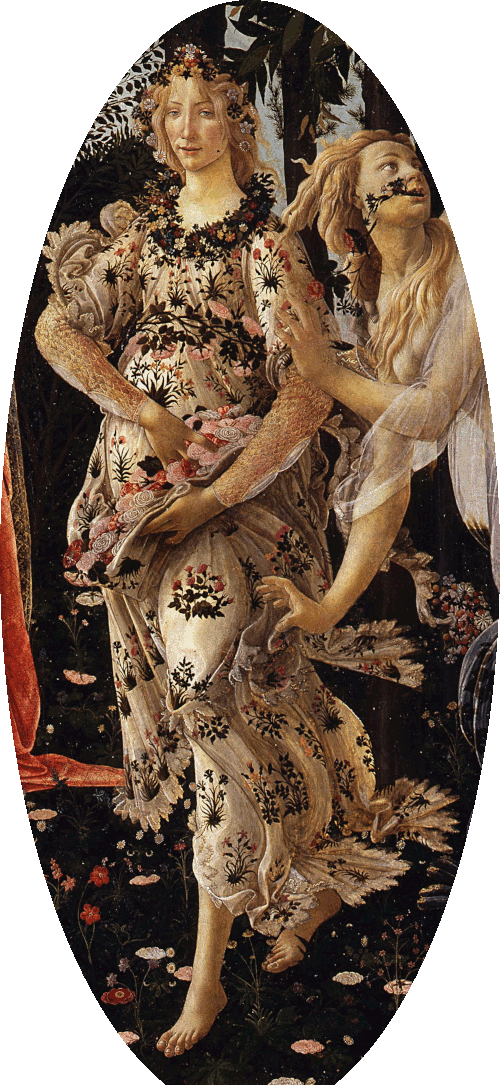
Woodland nymph
with Chloris |
- Chloris, the goddess of the flowers, was in the forest one day when she tripped over a beautiful nymph lying lifeless.
-
Saddened by the innocent creature’s fate, Chloris decided to breathe life anew, transforming the nymph’s body into a flower.
-
As a result, she created a new flower by breathing life into a woodland nymph who had died.
- Chloris was so overcome by the nymph’s fate that she reached out to the other gods to
help transform her into a very important and special flower.
|
if the myth does date back to ancient Greece it would help make sense of a nonsense line in Diocletian’s price edict of 301 AD, which in turn would mean that rosehips were a food cooked and eaten like a very small apple in Roman times.
(Howard Posner)
|
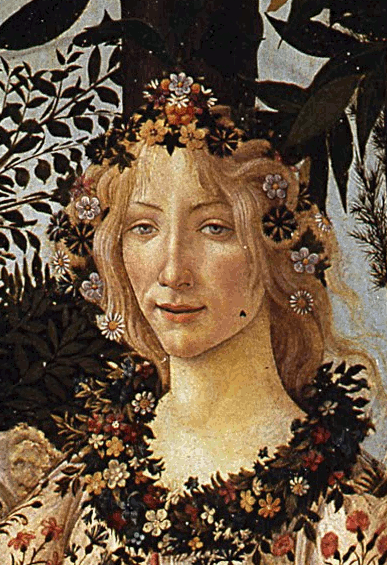
Rose has risen |
- Dionysus, the god of wine, gave the woodland nymph nectar for a sweet-smelling fragrance.
- The Three Graces gave Rose the Woodland nymph her beauty and splendor.
- Zephyrus blew away the clouds to allow the sun god Apollo to shine upon it, thus creating the first rose.
|
There's rosemary and rue. These keep Seeming and savor all the winter long. Grace and remembrance be to you.
(Shakespeare)
|
|
|
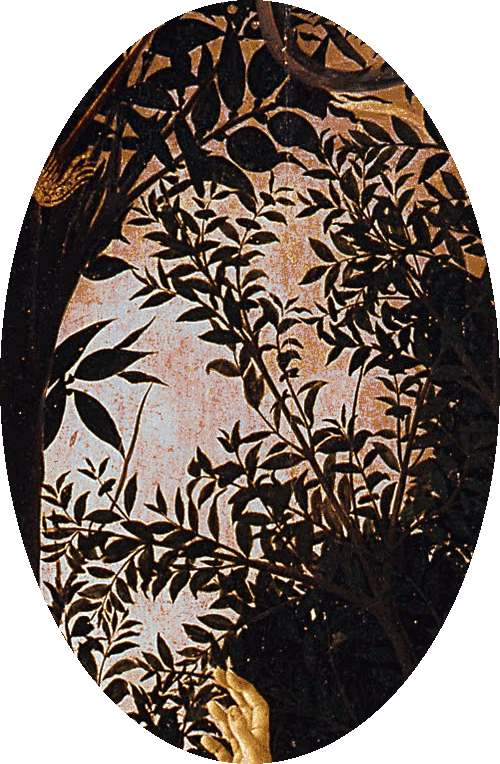
Iris |
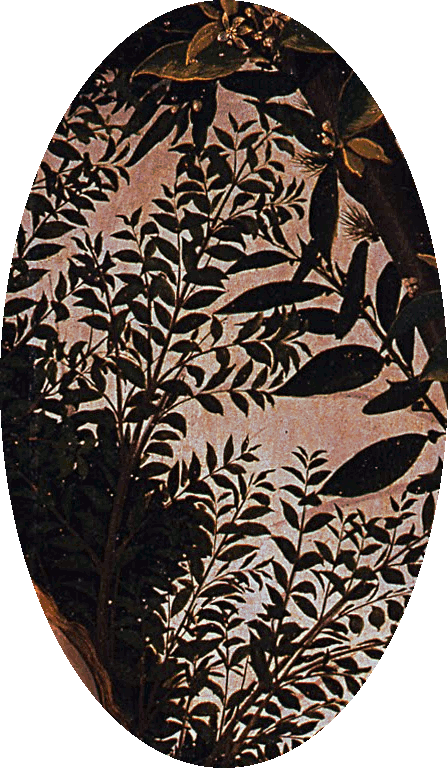
Aurora |
- Chloris then called upon Iris and Aurora to spread the word.
- Iris borrowed a touch of rose’s color, while Aurora painted the morning sky in rose-tinted hues.
- The distinctive shape of human lungs can be seen which
represents the breath of life.
- Visible in the drapery of
the robe above Flora's left arm, a dimple called the pulmonary
hilum can be seen from which bronchi, blood vessels and nerves
pass.
- The goddess is understood as anima mundi, or world
soul, and that is the unifying and life giving principle of
the multiplicity of imminent reality.
|
With both hands one nymph holds above the
spray-wet tresses a garland, burning with gold
and oriental gems, another adjusts pearls in her
ears; the third, intent upon those beautiful
breasts and white shoulders, appears to strew
round them the rich necklaces with which they
three girded their own necks when they used to
dance in a ring in heaven.
(Poliziano's la Giostra)
|
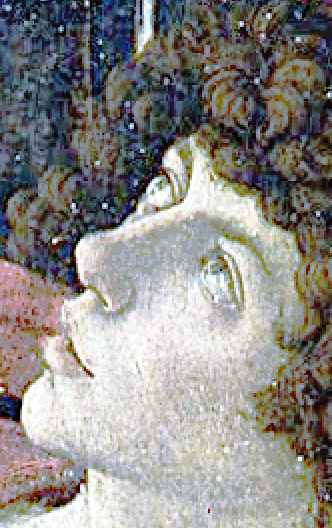
Eros |
- Aphrodite (Venus), the goddess of beauty and pleasure, gave the rose its name by rearranging the letters of Eros, her son and the god of love and desire.
- Eros later gave a rose to Harpocrates, the goddess of silence, as a bribe to ensure
she kept the indiscretions of the gods to herself.
- He was
hoping to cover up his mother’s recent indiscretions.
- Thus, roses would also come to be
associated with silence and secrecy (Latin: sub rosa meaning
‘under the rose’).
- In
the end, all agreed that rose was the most spectacular of flowers, truly
'The Queen of Flowers.'
|
Eros, thou yet behold’st me?
(Shakespeare, Antony and Cleopatra)
|

Rose in bloom |
- Because of all these gifts, the rose became symbolic of secrecy, silence, and love.
- This story was carried on into Roman mythology, with the protagonists replaced by their gods, Flora, Venus, Cupid, and Bacchus, although Harpocrates retained her Greek name.
- The association with secrecy led to the rose becoming a
visual symbol of the need for discretion.
|
Roses were carved into the ceilings and walls of public rooms in grand houses, courtrooms, and Catholic confessionals as a reminder that all conversations should be kept confidential. From the Middle Ages, a rose was often suspended from the ceiling of a government council chamber to ensure the secrecy of proceedings. Therefore, sub rosa (“under the rose”) became a quasi-legal term still in use to denote something that is best kept under wraps.
(Sheena Harvey)
|

Rose fossil |
-
The first rose species to be described for science came from the Florissant Fossil Beds in Teller County, Colorado.
- In 1883, paleobotanist Charles Leo Lesquereux wrote a scientific paper in which he described and named
Rosa hilliae, the simple rose-like specimen he had received
from samples found in the Princeton Scientific Expedition of 1877.
- His choice of name was to honor the amateur palaeontologist Charlotte Hill, who first brought the Florissant Fossil Beds,
where the specimens were found, to science’s attention.
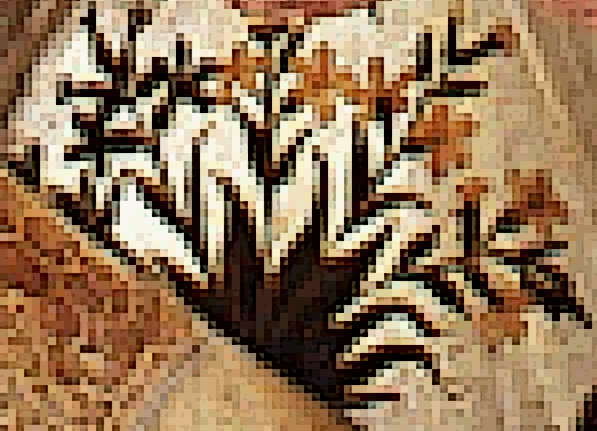
Rosa on hill |
- The first species roses had five single petals as seen on the flowers of
Rosa hilliae.
- These are the species that formed the genetic building blocks for our modern-day roses.
- There are 3 types of roses; Wild rose, Old-World roses and
Modern roses.
|
They include the dog rose, Rosa canina, which is commonly found in hedging. There is also the Scotch rose, Rosa pimpinellifolia, a tough, bushy rose that survives well in exposed or seaside locations, Rosa gallica, which comes from warmer southern Europe, Rosa carolina from the eastern US and Rosa blanda that toughs it out on the American prairies.
(Sheena Harvey)
|

Royal rose |
-
From being purely decorative, roses gradually took on a more symbolic significance when they started to appear in the emblems of nobility.
- In the 13th century, the white Rosa alba was the badge of Eleanor of Provence, wife of Henry III of England.
- Her son Edmund, Earl of Lancaster, adopted the red Rosa gallica from his wife Blanche of Artois when they married.
- This established the red rose as the mark of the House of Lancaster.
|
With sweet musk-roses and with eglantine: There sleeps Titania sometime of the night, Lull'd in these flowers with dances and delight.
(Shakespeare, A Midsummer Night's Dream)
|

Royal armor |
- More than 200 years later, Richard, Duke of York, chose the white rose as his badge.
- When the right to the crown of England was disputed by the House of Lancaster and the House of York between 1455 and 1487, the conflict became known as the War of the Roses.
- In 1986, the rose was chosen as the US’s official national flower by popular vote.
- But roses can be found all around the world, we have the
China rose, Middle Eastern and the Dutch were early pioneers.
|
He was met even now. As mad as the vex'd sea; singing aloud; Crown'd with rank fumiter and furrow-weeds, With bur-docks, hemlock, nettles, cuckoo-flowers, Darnel, and all the idle weeds that grow. In our sustaining corn.
(Shakespeare, King Lear)
|

Worldly |
- The results of roses grown in Holland in the 16th and 17th centuries can be seen in paintings by the Dutch Old Masters.
- A golden age for roses occurred in the early part of the 19th-century
and was driven by Joséphine de Beauharnais, wife of Napoleon Bonaparte,
a rose lover.
- Grandiflora roses began life in the 1950s as crosses between hybrid teas and floribundas.
- These tall, hardy bushes with full-blossomed flowers are the most familiar garden roses today.
|
This bud of love, by summer's ripening breath.
(Shakespeare)
|

DaVinci rose |
- The Chloris rose is nearly thornless and has darker green leaves,
with blooms that are pale pink with paler edges and a sweet fragrance.
- Leonardo DaVinci is a florabunda with double, perfectly formed, rosette shaped blooms of 75 petals in the style of English Roses.
- These are rich pink flowers and are produced in clusters
and have a mild fragrance.
|
A Rose, by any other name, would Smell as Sweet.
(Shakespeare)
|
|
Chloris becomes Flora |
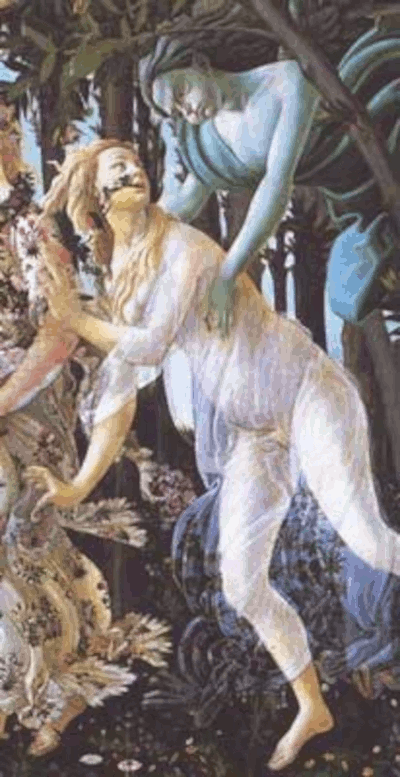
Zephyrus the west wind and nymph |
- On the right side, we see Zephyrus, borne on wings, the west wind, about
to take a nymph named Chloris, believed to have dwelt in the Elysian Fields.
- She was a Greek goddess,
associated with spring, youth, flowers and new growth.
-
Chloris looks back in fright at Zephyrus, who was a lustful
predator feared by many, and from her mouth a
chain of plants emerges.
|
I’ll sigh celestial breath, whose gentle wind
Shall cool the heat of this descending sun.
(Shakespeare, Venus and Adonis)
|
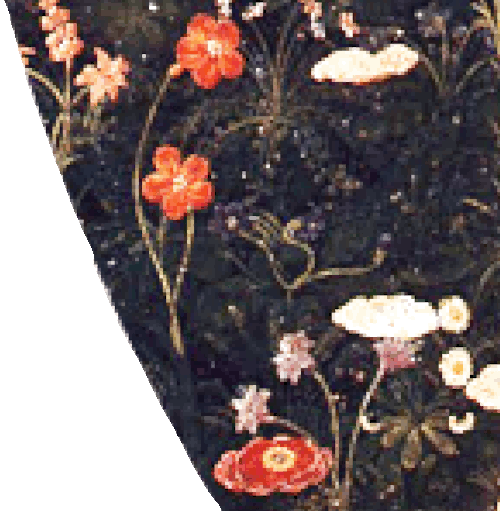
Flower garden |
- Chloris
is also a European Greenfinch sitting on an ivy log.
- She is credited with turning several figures into flowers, including Adonis, Attis, Crocus, Hyacinthus, and Narcissus.
- Botticelli included over 150 different plants in the
scene besides bitter orange trees such as fir trees, lilies of
the valley and daisies.
|
In Greek mythology, the Elysian Fields, also known as Elysium, is a paradise within the Underworld where the souls of heroes and the virtuous reside. It's essentially the Greek equivalent of heaven. Originally, it was reserved for heroes and those granted immortality by the gods, but later expanded to include the blessed dead and those who lived righteous lives.
(Assistant)
|
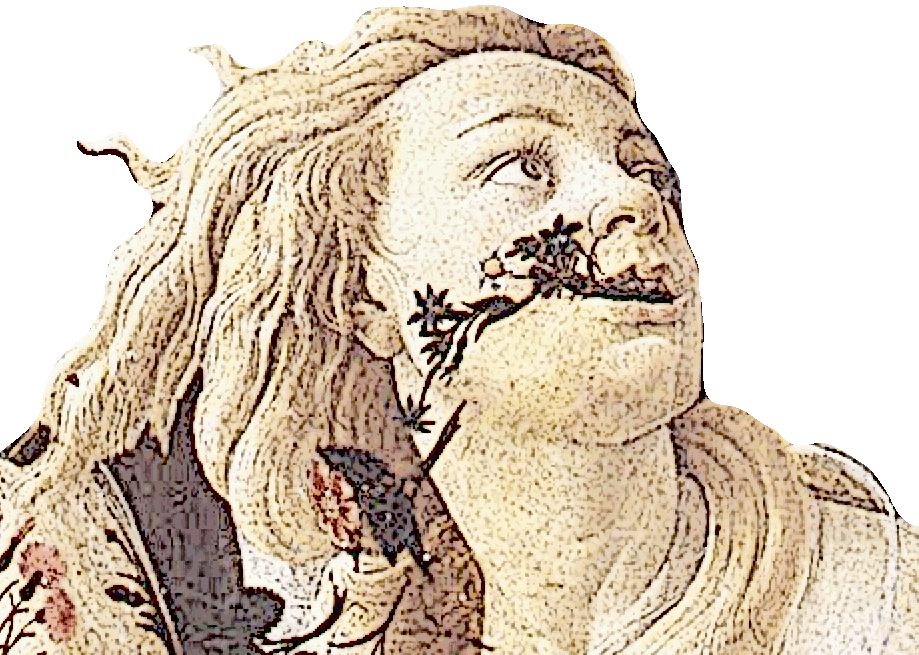
Flora spring goddess
with ivy |
- After Zephyrus succeeds in taking her for his own, they are married and Chloris transforms into Flora.
- The vine growing from her mouth is a symbol of unwanted
conception.
-
Both names make clear her association: Chloris is derived from chloros, Greek for the brilliant yellow-green of Spring vegetation.
- In the name Flora, the Romans associated her with the flowers of the Spring, and their blossoming.
|
The common English names for Chloris virgata are
feather fingergrass and feather windmill grass. It is
also sometimes referred to as feathery Rhodes-grass.
(Assistant)
|

Moist air |
-
Zepharus was famed for bringing warm, moist air to the Mediterranean in spring, thus bringing the first crops on after the winter.
-
Chloris/Flora is often linked with Demeter, the goddess of agriculture, and Persephone, who represents spring's return.
-
Together, Chloris and Zephyrus had a son named Karpos.
|
O Chloris, weigh the task I undertake!
Thy beauty subject of my song I make.
(William Smith, Elizabethan Sonnet-Cycles)
|
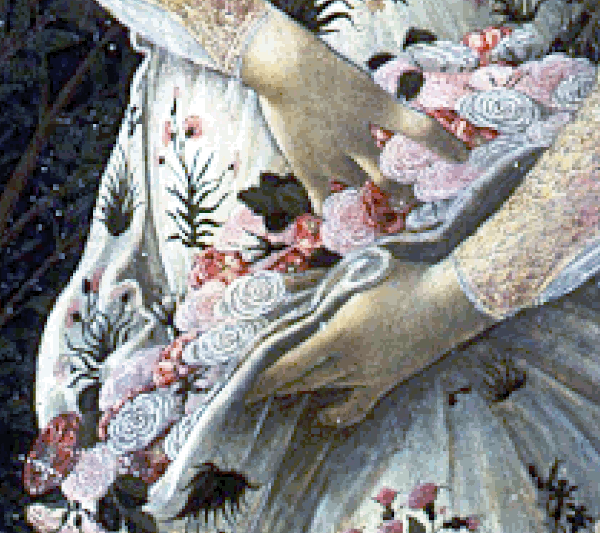
Flora spring goddess with flowers |
- Here, in the forest of Primavera, Flora is depicted throwing flowers that have been
gathered in her dress which symbolizes both springtime and fertility.
- Chloris/Flora is referred to in several classical
sources, but the most complete account of her origin is given
not in Ovid’s Metamorphoses, but in his Fasti, covering the day of 3 May.
- Fasti is a calendar of feasts and gods, detailed in Latin verse.
- Flora is the botanical term for vegetation of a particular environment.
|
As she talks, her lips breathe spring roses:
I was Chloris, who am now called Flora.
(Ovid, Fasti (V.194-195))
|
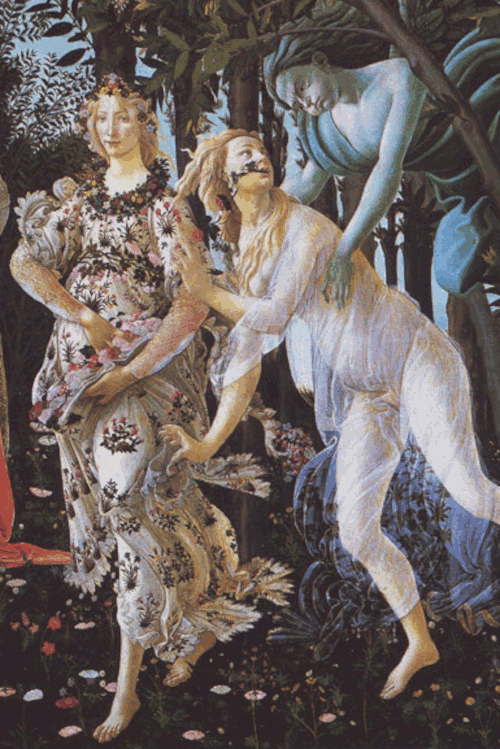
Abduction turns into conversion |
- Ovid explain how Zephyrus, the god of the west wind, raped and then made a bride of the nymph Chloris, who promptly metamorphosed into Flora, shown most elaborately in Botticelli’s masterpiece
Primavera.
- Chloris/Flora were also depicted blossoming
by Botticelli in Birth of Venus.
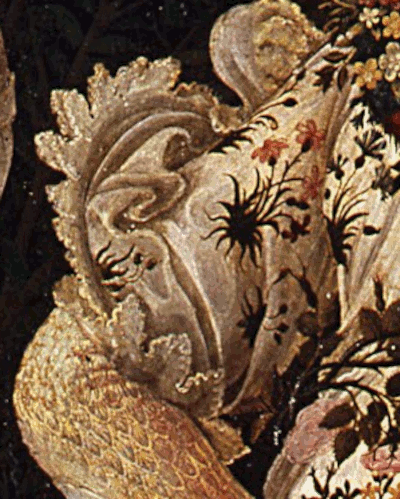
Flora's robe |
- Botticelli (as did the Romans) has transformed this figure from Greek mythology into Flora, her Roman counterpart.
-
Flora, who is dressed in a robe bearing images of many different flowering plants, wears a garland of flowers in her hair, and
is casting flowers from a bouquet held in her arms.
|
If her name change isn’t enough, then it has been claimed quite widely that the underlying reason for the Romans calling her Flora, hence the story of metamorphosis, is because of their inability to pronounce her Greek name of Chloris. Attractive though that might appear, it’s sadly completely false, and Latin borrowed and assimilated many other similar words without finding them tongue-twisters.
(eclecticlight.co)
|

Black Dahlia |
-
According to Ovid, Flora helped Juno (Hera) who was angry that Jupiter
(Zeus) had produced Minerva (Athena) from his own head, become pregnant with Mars
(Ares) by giving her a magic flower.
|
Juno is a powerful Roman goddess, primarily known as the queen of the gods, goddess of marriage, and protector of women. She is the Roman equivalent of the Greek goddess Hera. Juno is associated with childbirth, motherhood, and the well-being of women and families.
(Assistant)
|
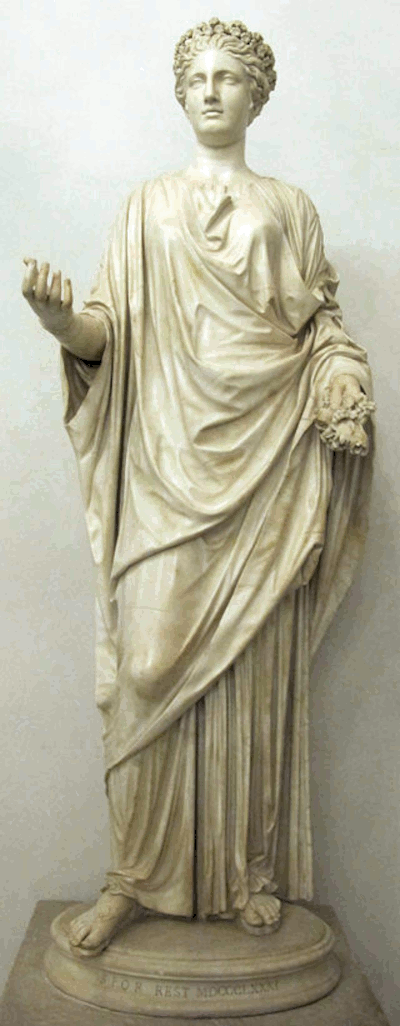
Sailko, CC BY 3.0 , via Wikimedia Commons
Flora
in the Capitoline Museum |
- Flora, in Roman religion, the goddess of the flowering of plants.
- Titus Tatius, who according to tradition, was the Sabine king who ruled with Romulus, is said to have introduced her cult to Rome.
- Flora's temple stood near the Circus Maximus.
- There
were priests, known as Flamen Floralis, who presided over the
many Roman cults dedicated to her.
- Her festival, called the Floralia, was instituted in 238
BC.
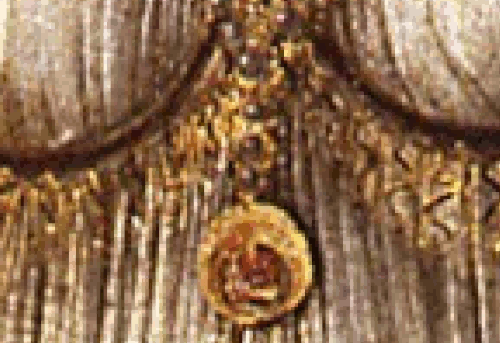
Florin coins |
- Flora’s head, distinguished only by a floral crown, appeared on
the Florin coins of the republic.
|
Seeds spring from seeds, and beauty breedeth beauty;
Thou wast begot; to get, it is thy duty.
(Shakespeare, Venus and Adonis)
|
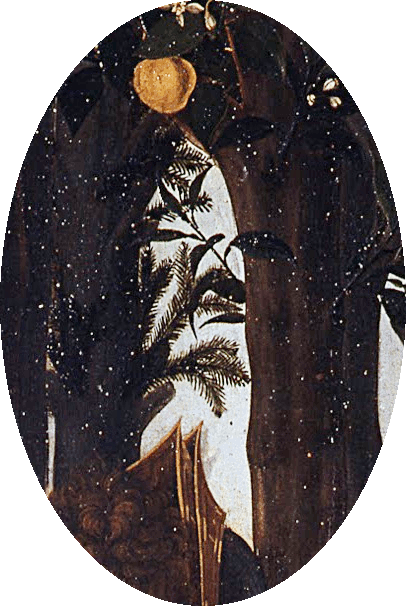
Sanquine personality |
- On one side of the painting Venus and Zephyrus are
contrasted by an emothionally sanquine and material Mercury.
- Opposites who circulate the vital fluids present in the
scene, purifying and transforming it through Venus' breath.
- The life forces of each of the four main temperaments types;
sanguine (cheerful and socialble), choleric (ambitious and
assertive), melancholic (introspective and analytical) and
phlegmatic (calm and steady).
|
The Four Temperaments model suggests four fundamental personality types: Sanguine, Choleric, Melancholic, and Phlegmatic. These types, rooted in the humoral theory, are thought to be based on the balance of bodily fluids, with each temperament associated with a specific fluid.
(Assistant)
|
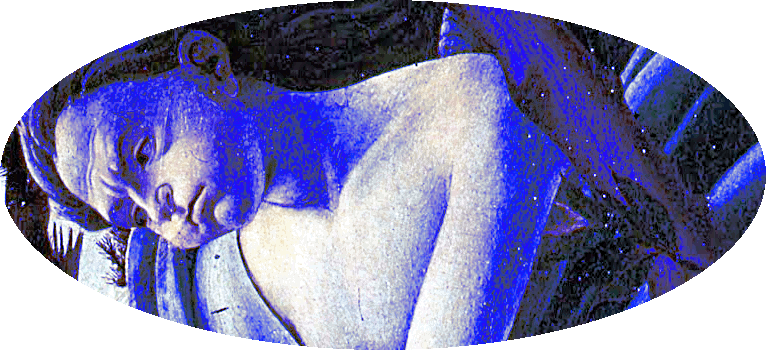
Blue aura of Zephyrus |
- This movement of life force is represented by the blue
aura of Zephyrus contrasted to the pink of the cloak held up
by Flora.
- Referring to the Marine microcosm in which
the macrocosm os revealed perpetually producing an eternal
return and infinite life cycle.
- Hence, time is also the
protagonist of the work, in which is the light coming from the
East, as evidenced by the shadow of the shell.
- It reveals
rose-fingered Aurora who prepares the world for yet another
new beginning.
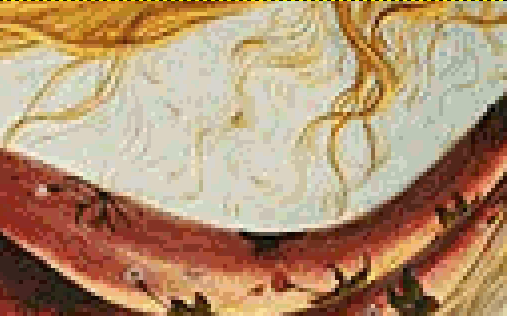
Dawn of nature |
- For the dawn of nature will flood the whole world with
brightness and life.
- Botticelli's Birth of Venus
represents the life cycle starting from transcendence and
merging into contingency.
- While in the spring of
Primavera, we find the principle of contingency transforming
back into transcendence.
- Botticelli was able through his
work to intertwine Christian and biblical concepts exposed
through pagan symbolism merged together in this work, fused in
an innovative language of imagery.
- Through Greek Olympian
images, he sends symbolic meanings of a moral, philosophical
and theological nature endowed with multiple keys of
interpretation.
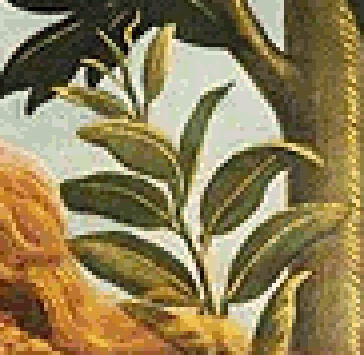
God's work |
- That is why Botticelli's work is so similar to DaVinci's Baptism of Christ and is able to merge the
mythological and the evangelical in synergy with Florentine
neoplatonic philosophy.
- Portraying the goddess of beauty
as the intermediary between God and man, in that through
beauty, God draws humanity to himself.
- Because of this,
we are able to discover the immensity and omnipotence and
glory of God through beauty which we learn as initially
earthly nature, then turning to a higher level spiritual
beauty.
|
The artist has the ability to show through a physical image a spiritual truth.
(Ars Europa Channel)
|
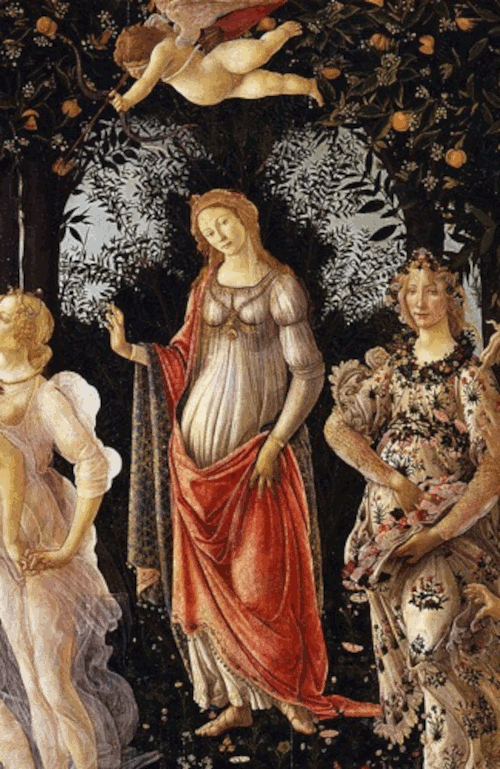
Springtime marriage |
- The allusions to Spring and the month of May, the scene of a suitor’s pursuit, the Three Graces, all point to the idea of a springtime marriage.
- In any case, the painting is a testament to humanist interests in classical subject matter in the Renaissance, as well as the courtly desire for lavish themes and graceful figures.
|
Chloris breathes life into a deceased nymph, creating
the first flower, symbolizing eternal beauty and life.
(Assistant)
|
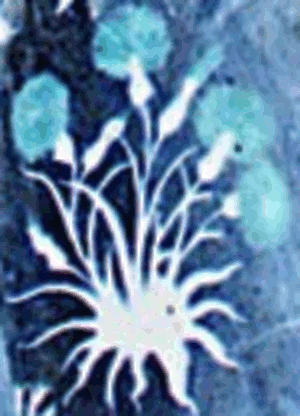
Enigmatic |
- Like all interpretations, these offer insight, although Primavera remains an enigmatic puzzle that defies singular definition.
- In the artful style of an old master, Botticelli's intricate symbolism allows for multiple layers of meaning, inviting viewers to bring their own perspectives
nnd interpretations.
|
Now, my fairest friend, I would I had some flowers o' the spring."
(Shakespeare)
|

Forget me not |
- You might say that the painting has
an enduring allure that has the ability to captivate the imagination
and understanding of the connectiveness of our world
throughout all time.
- It is a reflection of the era's aspiration to bridge the gap between the past and the present, the divine and the human, through the transformative power of artistic expression.
|
When daisies pied and violets blue. And lady-smocks all silver-white. And cuckoo-buds of yellow hue. Do paint the meadows with delight.
(Shakespeare, Love’s Labours Lost)
|
|

